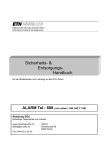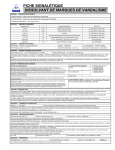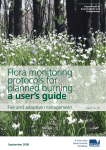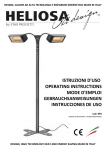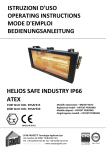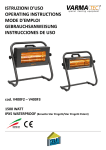Download Operating Instructions - Universität Duisburg
Transcript
Date: 01/2009 Page 1 of 10 University of Duisburg-Essen, Department of inorganic chemistry Group: Prof. Dr. S. Schulz Operating Instructions Operating instructions according to § 14 of the “Ordinance on Hazardous Materials” [Gefahrstoffverordnung] and the “Rules for safety and health protection for laboratories” [Regeln für Sicherheit und Gesundheitsschutz für Laboratorien] respectively These general laboratory regulations lay down basic behavior in the lab, point out specific dangers, and regulate dealings with hazardous materials. They are obligatory and must be known by and easily accessible to all the employees. The latter should strictly follow and adhere to each of these regulations. Specifically the following texts concerning laboratory work are also binding and have to be followed: - Guideline of prevention [Grundsätze der Prävention - GUV-VA1] - “Rules for safety and health protection for laboratories” [Regeln für Sicherheit und Gesundheitsschutz für Laboratorien: GUV-R-120 (GUV 16.17)] - Rules for safety and health protection for contact with hazardous materials in universities [Regeln für Sicherheit und Gesundheitsschutz beim Umgang mit Gefahrstoffen im Hochschulbereich: GUV-SR-2005 (GUV 19.17)] - Lists of hazard symbols, description of hazards, R- and S- phrases [Listen mit Gefahrensymbolen; Gefahrenbezeichnungen; R- u. S-Sätze] - Lists of all substances used in the lab with the appropriate R- and S- phrases - Instructions for substance classes [Gruppen-Betriebsanweisungen] - Specific instructions [Einzelstoff-Betriebsanweisungen] - Current safety data sheets [Aktuelle Sicherheitsdatenblätter] (from their issuer) - Special instructions for instruments and procedures [Spezielle Betriebsanweisungen für Geräte und Verfahren] Page 2 of 10 1 - University of Duisburg-Essen: „Guidelines for waste disposal“ [Abfallentsorgungs-Richtlinie der Universität Duisburg-Essen ] - University of Duisburg-Essen: “Fire safety regulations and alarm plan” [Brandschutzordnung mit Alarmplan der Universität Duisburg-Essen] All these rules, instructions, current safety data sheets, as well as the lists of substances and waste disposal directions, etc., can be found in the lab safety folder! The lab safety folder provides the general laboratory rules and regulations as well as basic information for the safety meeting which should be held at least once a year. Special accident prevention rules and instructions or important safety tips should also be considered for various substances used in the laboratories. 1. General Rules • Unauthorized persons are not allowed in the labs. • Pregnant women, nursing mothers and youth under 16 are strictly forbidden, to work with hazardous materials in the lab. • Youth between 16 and 18 may are allowed to work with hazardous materials only under control. • Eating, drinking and smoking is prohibited in the laboratory. • Each person must keep his or her work place clean and orderly. • Passages and escape routes must kept clear. It is forbidden to obstruct them with objects of any sort. • Fire doors are to be kept shut. The self-closing mechanism may not be hindered or blocked. • There must be a second person present for hazardous tasks outside normal work hours. • Lab coats and shoes: A lab coat of not easily inflammable material (i.e., cotton blends) should be worn. Only closed, non-slippery shoes may be worn. • Goggles: Goggles must be always worn in the laboratory. People wearing glasses for their vision should have a pair of optically corrective goggles or a pair of larger goggles to wear over their own • It is absolutely forbidden to pipette with your mouth Page 3 of 10 2 • Safety hoods - Safety hoods should prevent inhalation hazardous substances while working and provide protection from splashing hazardous substances or flying pieces of broken glass. - Safety hoods may only be used if their safety inspection is up to date. - Hoods can only function properly, if the front and side panels are shut. When working in the hood, the front panel should not be open more than necessary. It must always be kept down enough to protect the head of the user and shut when the work is over. - There should be no more chemicals in the safety hood than necessary for the actual work. Shelves may not be put in hoods. - Harmful substances should be only released, even in the hoods, by accident or while filling an apparatus. Excess reaction gases, vapors, aerosols, or dust, which occur during normal work, should be contained by special measures (i.e., by appropriate arrangements of gas-washing bottles or specific filters). - Substances, which might give off highly toxic, toxic, carcinogenic, mutagenic, teratogenic, harmful, corrosive, or inflammable gases, vapors, aerosols, or dust may only be used within hoods. - If the used air is not being drawn out of the hood, stop working and turn off the apparatus (coolants should be allowed to continue). Inform your superiors. • Electrical appliances - Electrical appliances must be inspected before every usage for signs of outer damage. - Defective or damaged appliances may not be used anymore and should be reported to the local superiors. - Repairs should only be done by electrical technicians. Inspection of electrical appliances: - The month and year in which the last inspection took place is shown on the top of the inspection sticker. - Inspection are performed authorized personal. - If the date of safety inspection has been exceeded, the electrical appliance must be inspected immediately. • Drying ovens: The safety thermostats on drying ovens must always be used. They must be checked regularly for function. • Autoclaves Read and pay attention to the information on their usage and possible hazards in the operating instructions. Page 4 of 10 3 • Distillation instruments - Make the proper arrangements so that the heater automatically turns off in case of water failure. - Measures to avoid delayed boiling should be taken. Follow the posted instructions. • Working with evacuated equipment - For protection from flying pieces of glass resulting from implosion, glass containers should be covered with a protective adhesive film, shrink wrap, basket, or shield. - Work with a rotary evaporator should be likewise done in a closed hood or behind a protective shield. • Long-term experiments Are only permissible as an exception! All lab experiments need constant supervision. Long-term experiments running without supervision must be set up safely so that no damage or accidents can occur if there is an unexpected energy, water, or other kind of failure. Experiments that run after work hours or overnight should be equipped with a cut-off plan and registered with the superiors in charge. • Further information - Personnel from outside the laboratory Cleaning personnel: Cleaning personnel may clean laboratory rooms in the absence of laboratory personnel. This means that after work: - all very toxic, toxic, carcinogenic, mutagenic, and reproductively toxic substances must be locked up; - corrosive and inflammable liquids must be stored so that they cannot be knocked over by cleaning personnel (i.e., in cabinets). Workmen: If workmen have a job to do in the laboratory, the lab personnel must free a large area of any chemicals for them to do their work without risk of endangerment. The workmen may not do this themselves. Workmen must be informed of any possible dangers and be sufficiently supervised. 2. Handling hazardous substances • Hazardous substances identification Substances and mixtures (preparations) having at least one of the following properties are characterized as hazardous substances (distinguishing sign in parentheses) Page 5 of 10 4 explosive (E) very toxic (T+) oxidizing (O) extremely flammable (F+) toxic (T) harmful (Xn) highly flammable (F) corrosive(C) flammable irritating (Xi) carcinogenic (T) or suspected (Xn) sensitizing (Xn o. Xi) embryo-/fetotoxic (T) or suspected (Xn) dangerous for the environment (N) mutagenic (T) or suspected (Xn) Special regulations: Radiation Protection Ordinance [StrahlenschutzverordnungStrlSchV], apply to radioactive substances. Special regulations of the Ordinance on Biological Agents at Work [Biostoffverordnung BioStoffV] apply to biological substances (i.e., infectious ones). Special regulations, Genetic Engineering Safety Ordinance [Gentechniksicherheitsverordnung-GenTSV], apply for handling genetically modified organisms. • Identification signs - Every container in the laboratory must be clearly marked for its contents. - The identification signs of hazardous substances must include, in addition to the substances, names, their hazard properties, symbols, and R- and Sphrase numbers. - A list of the R- and S- phrases and their explanations is placed in the lab safety folder - Labels with hazard symbols can be obtained from the chemical materials stores or appropriate technical companies. - Containers of waste substances must also be marked for their potential hazards. • Cadastre - There must be a list of all the hazardous substances present in the laboratory (see lab safety folder). The lists must be kept up to date and checked at least once a year for completeness. There should be a constant control of whether any of the hazardous substances can be omitted or substituted for less dangerous ones. • Storage of hazardous substances in the laboratory - Storage of hazardous substances in the lab is forbidden. Only the amount of hazardous substances needed for working may be present in the lab. Page 6 of 10 5 - Hazardous substances may not be kept in containers which might be confused for food. Containers should be of an appropriate material for storing the corresponding substance. • Flammable liquids - Flammable liquids for hand usage should not be stored in containers able to hold more than 1 liter. In case even larger amounts are necessary for working they must be kept in a safety closet. - Flammable liquids may not be put in normal refrigerators (including freezer compartments or freezers). If flammable liquids have to be kept cool, then the appliances have to be adapted. The insides of converted refrigerators must be protected from explosions and there must be a warning sign on the outside of these refrigerators and freezers. All substances and preparations with the following hazardous properties are to be kept under lock and key [poison cupboard / Giftschrank]: R 26 very toxic by inhalation. R 27 very toxic in contact with skin. R 28 very toxic if swallowed. R 45 may cause cancer. R 49 may cause cancer by inhalation. R 46 may cause heritable genetic damage. R 60 may impair fertility. R 61 may cause harm to the unborn child. R 64 may cause harm to breastfed babies. and/or with the safety tip: S 53 avoid exposure - obtain special instructions before use. Each laboratory employee must be informed of the special hazards of the substances before he or she uses them. • Operating instructions - Pay strict attention to the operating instructions of the substances and of potentially very hazardous procedures. Page 7 of 10 6 • Personal protective equipment - The safety tips (S-phrases) and given means of protection for the body (i.e., face protectors, goggles and gloves, hand creams) are to be available at all times and used. 3. Handling of Gases • Compressed-gas cylinders - If possible, only small pressure cylinders should be used. Their number must be held to a bare minimum. Storage is not permitted! - Compressed-gas cylinders may only be placed in areas where clamps are available. The clamps must be located on the cylinder's upper third, but not near its valve. - The cylinders should only be taken from a permanently installed fixture at the work place for usage. If this is not possible, the superior in charge must approve any other arrangement for their placement. - The cylinders must be kept in heat insulated safety closets or brought into a storage room or heat insulated safety closet after usage) - The air in the experimental setup has to be exhausted as well after using very toxic and toxic gases (work under safety hood). - Compressed-gas cylinders containing inert gases may be set up in the open in rooms with only a small amount of fire load (e.g., flammable liquids, packaging materials, etc.) - Compressed-gas cylinders may only be transported with the protective cap screwed on. They may not be transported in elevators together with people. - If the cylinder's valve cannot be opened by hand, it must be returned to storage or the supplier. Do not use pliers or other tools on it. • Liquid nitrogen Pay attention to the operating instructions. Use protection device provided for the body like goggles, face protection, and gloves. When dealing with larger amounts, also when decanting, make sure there is enough ventilation. 4. Waste reduction and disposal • The amount of chemicals and solvents used should be kept to a bare minimum as much as possible. Here it is a matter of "recycling is better than dumping." • Avoid polluting sewage with water contaminating substances. • The disposal center [Zentrales Entsorgungslager] organizes and carries out waste disposal. Page 8 of 10 7 • The disposal center [Zentrales Entsorgungslager] provide containers for waste disposal. It also has the accompanying forms necessary for waste disposal. The containers must be marked as specified in the regulations. • The rules about keeping collected solvents separated from each other must be strictly followed! • In particular, waste-containing liquid halogens must be collected and kept apart from halogen-free liquid waste. • Additional need of or disposal of chemicals must be also requested from the disposal center [Zentrales Entsorgungslager]. 5. Behavior during dangerous situations People should be protected before objects are! • Stay calm and avoid hasty, senseless acts. • Warn endangered people and if necessary, get them to evacuate. • A doctor must be visited and the company doctor [Betriebsärztlicher Dienst] notified in case of injuries, nausea, skin reactions, as well as contamination with infectious substances. • Secure information for the doctor. Use the lab safety folder to prepare the information that must be given to the doctor. (safety data sheet, individual instructions, vial labels, etc.) • See the first aid notices hanging in the laboratory for first aid measures. • An accident report must be filled out for every accident and the completed form sent to the administration of the university. A superior must sign the accident report. • The following numbers must be immediately called in the case of loss of limb, very serious accidents, or death: Emergency number: 112 (fire brigade) Safety personnel Dr. W. Habel 3925 or Dr. A. Kuczkowski 6143 Superior • Fire (Continuous tone of the signal horn): - If a fire breaks out, the university fire protection regulations and the locally established rules are to be paid attention to and followed. Page 9 of 10 8 It is particularly important to - call the emergency number 112 or - if appropriate, press the emergency call button. - If it is possible to do so without endangering anyone, fight the fire with the available fire extinguishers until the fire brigade arrives. - Have someone meet the fire department vehicles at the street and show the way to the fire. - Everyone not involved in extinguishing the fire or first aid measures must leave the endangered area. - Keep windows and doors shut. - Do not use elevators. - Put out fires on clothing with fire extinguishers and/or emergency showers or smother them with fire-fighting blankets. - If possible, warn endangered people in adjoining areas and tell them to evacuate. Inform the responsible group head or class leader. • If dangerous gases escape (Continuous tone of the signal horn): - Close valves or provide good ventilation if it is possible without selfendangerment. - Stay away from the source feeding combustible gases and do not use switches for electrical current. - Inform your superiors. • Emergency equipment - Emergency equipment consists of emergency showers for employees, eyewash stands and/or eye-wash bottles, hand fire extinguishers, main switches for electrical current, valves for shutting off gas, first aid kits, etc.. - All employees must know where the emergency equipment is located and how to use it. - All emergency equipment must be clearly visible, recognizable, and easily accessible. It may not be covered or removed. - Emergency showers for employees and eye-wash stands are to be tested once a month. The examination dates should be listed. Page 10 of 10 9 - Hand fire extinguishers, which have been used or opened (even including damaged seals), must be immediately exchanged and reported to the Technical Service (Tel. 3170) - First aid kits must be regularly checked for completeness (Safety personal). Don´t leave the campus in case of an emergency! Go to the designated meeting point in front of the building S 07! (see alarm plan) Sicherheitsbeauftragter Prof. Dr. S. Schulz Dr. W. Habel 10










